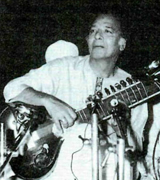On Hindustani Music
The Experience Of Melody: From Dhrupad To Santoor

Whether we hear Malkauns in a dhrupad recital, or in a khayal performance, or on the sitar, sarod, or santoor, we relate easily to the raga in each of these modes of presentation. This is more remarkable than it seems at first sight; for, each of these is a different genre, with not only its own architecture, its own way of relating the melody to the non-melodic facets of music—the poetic, the rhythmic, and the acoustic—but also a substantially different treatment of melody. Collectively, these genres add to the overall richness of the melodic experience of contemporary Hindustani music. And, as alternatives available to our generation of listeners, they oblige us to acknowledge the robustness of our raga-s, which sustain their raga-ness across several categories of melodic experience.
But, there is yet another way of looking at this diversity. It did not evolve simultaneously, but sequentially. Considering the phenomenon in a historical perspective, starting from the dhrupaddominated period (13th to 18th centuries) and approaching the santoor-dominated era towards which we may be heading, we can observe some patterns in the changing music-scape. These patterns suggest a progressive fragmentation of the melodic experience, and a growing emphasis on non-melodic facets of music. This trend has implications for the direction Hindustani music can take in the future.


